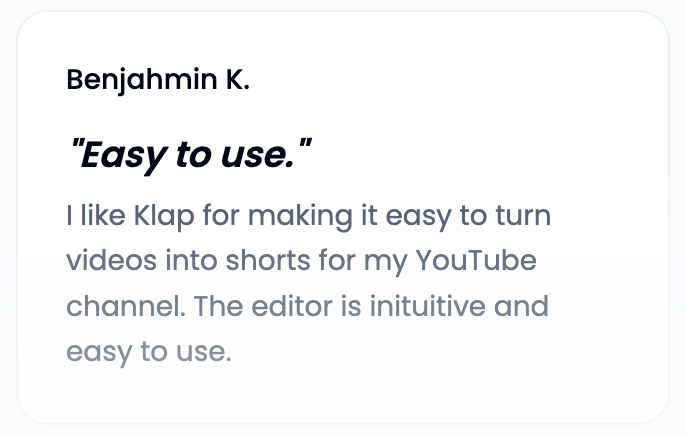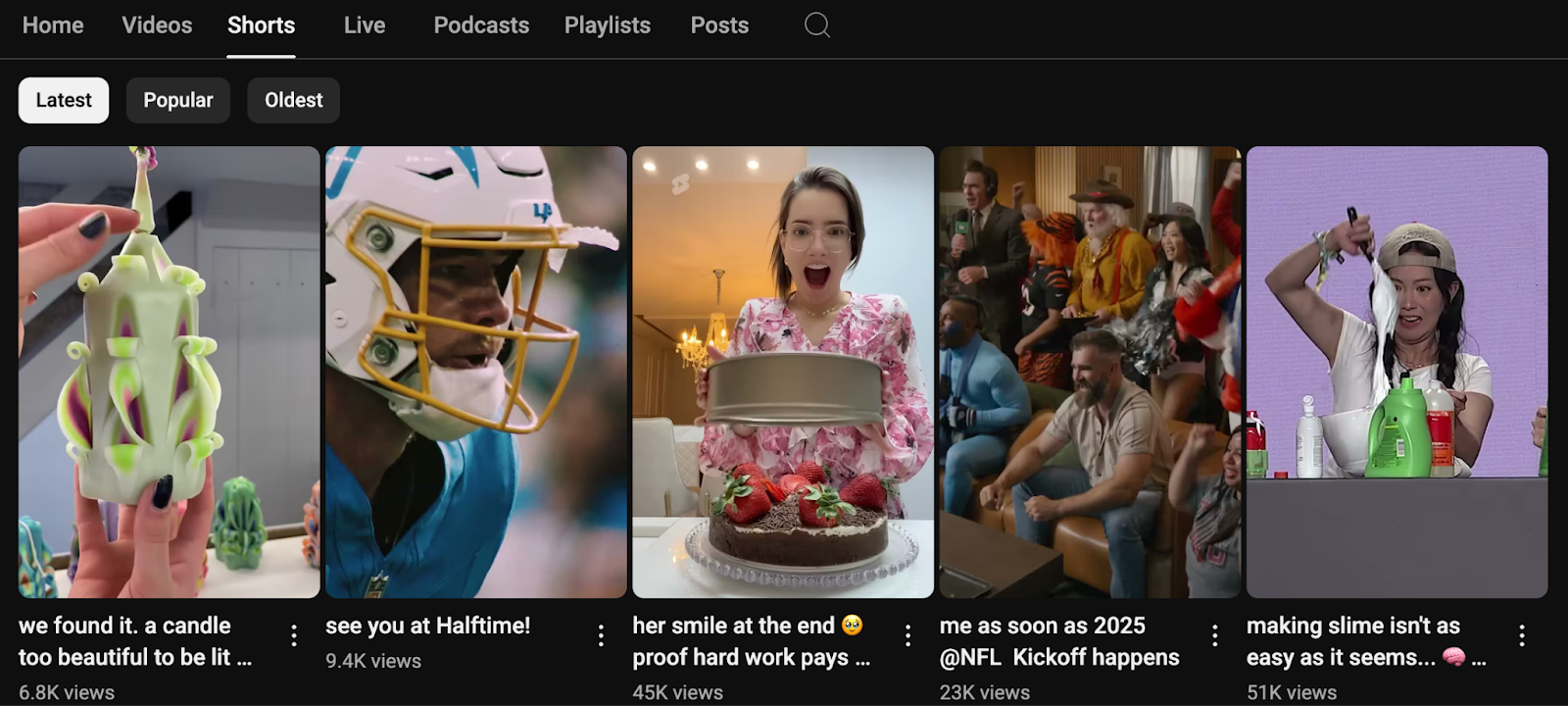When is The Best Time to Post YouTube Shorts For Maximum Views?
Content Creation
Quick Summary
Posting at the right time can significantly impact the performance of your YouTube Shorts. The right timing helps you reach more viewers and increase engagement. This guide explains the best times to post, the factors that matter most, and how to spot when your audience is most active.
Struggling to Know the Best Time to Post Your YouTube Shorts?
You're not alone. Most creators post randomly and wonder why their videos don’t take off, while other similar videos perform well.
The difference often comes down to strategic timing. YouTube’s algorithm favors videos that pick up traction quickly, so the first few hours after posting can make the difference between a Short getting a few hundred views or reaching millions.
In this Klap article, we will show you the best times to post YouTube Shorts, what factors influence timing, and how to find your audience’s peak activity so your videos perform better.
Why Listen to Us
At Klap, we’ve worked with thousands of creators and analyzed real posting data to see what actually drives views. With over 1.7 million creators producing 3.3 million clips on our AI-driven platform, we’ve built unmatched insight into what works on YouTube. That’s why we know that strategic posting, paired with great content, drives real growth.

What Are YouTube Shorts?

YouTube Shorts are vertical videos up to 60 seconds long, built to compete with TikTok and Instagram Reels. Since its launch, they’ve quickly become a tool for creators to grow their YouTube channels, driving over 70 billion views every day. Shorts show up in the YouTube Shorts shelf, search results, and the main feed, giving you multiple chances to get discovered.
Best Times to Post YouTube Shorts
These are strong starting points, but remember, your audience may behave differently.
- Monday: 11 AM - 3 PM, 4 PM, 7 PM - 10 PM (EST)
- Tuesday: 11 AM - 3 PM, 7 PM - 10 PM (EST)
- Wednesday: 12 PM - 3 PM, 4 PM (Best), 7 PM - 10 PM (EST)
- Thursday: 12 PM - 3 PM, 4 PM, 7 PM - 10 PM (EST)
- Friday: 12 PM - 3 PM, 7 PM - 10 PM (EST)
- Saturday: 9 AM - 11 AM, 5 PM - 7 PM (EST)
- Sunday: 9 AM - 11 AM, 5 PM - 7 PM (EST)
Weekdays (Monday-Friday)
- 11 AM to 3 PM and 7 PM to 10 PM on Mondays and Tuesdays.
- Peak engagement often comes from 12 PM to 3 PM and 7 PM to 10 PM.
These times reach both lunch-break viewers and evening audiences. Afternoon works well for educational or how-to content, while evenings favor entertainment and lifestyle Shorts.
Specific Day Performance
- Wednesday at 4 PM delivers the highest engagement.
- Thursday at 4 PM and Monday at 4 PM follow closely.
This suggests midweek posts have strong visibility.
Weekends (Saturday-Sunday)
- 9 AM to 11 AM (weekend early risers).
- 5 PM to 7 PM (viewers winding down).
Weekend patterns shift significantly as people have more flexible schedules. Late morning captures the weekend-early-risers, while early evening reaches those winding down from weekend activities.
Universal High-Performance Window
Across niches and demographics, 2 PM to 4 PM EST (Monday - Thursday) stands out. This slot works because it overlaps:
- East Coast: Afternoon breaks.
- West Coast: Lunch hours.
- Europe: Evening leisure time.
The 3 PM EST “sweet spot” often drives sustained engagement, since it connects all three audiences at once.
Time Zone Strategy
For creators with global reach, 12 PM to 3 PM EST offers the best balance, because it reaches:
- US East Coast: Afternoon.
- US West Coast: Late morning/lunch.
- Europe: Evening.
- Asia: Late night/early morning (varies by region).
Factors That Affect Optimal Posting Times
Audience Demographics
- Age Groups: Pew Research data shows that younger audiences (18-29) are most active during evening hours (7-11 PM), while older demographics (30-49) show higher engagement during commute and lunch hours. Professional audiences peak during lunch breaks (12-2 PM) and early evenings (5-7 PM).
- Geographic Location: Your viewers’ location matters more than your own. Check YouTube Analytics to see where your audience is based. For example, if most of your viewers are in the US, focus on American time zones, even if you’re posting from somewhere else.
Content Niche Performance
- Educational Content: Performs best during commute hours, 7-9 AM and 5-7 PM, when people want to learn something productive on the go.
- Entertainment Content: Peaks in the evening, 7-10 PM, as viewers unwind and look for light, fun content.
- Business/Professional Content: Gains traction around 12-2 PM during lunch breaks and in the early evening, when professionals are catching up on social media.
Seasonal Variations
- Summer Months: Viewers are mostly outdoors in the evenings, so posting earlier in the day can capture more engagement.
- Holiday Seasons: Habits shift dramatically during holidays and school breaks. Test different posting times to see what works best.
- Back-to-School Period: In September and January, routines change, and so do viewing patterns. Adjust your posting schedule to match these shifts.
How to Find Your Audience's Peak Hours
Using YouTube Analytics

Navigate to YouTube Studio > Analytics > Audience and examine the "When your viewers are on YouTube" section. This data shows exactly when your specific audience is most active, broken down by days of the week and hours of the day.
Look for:
- Daily peak hours: Identify your top 3-4 hour windows each day
- Weekly patterns: Notice if weekends differ significantly from weekdays
- Long-term trends: Review 90+ day data to spot seasonal changes
- Real-time data: Check if recent months show different patterns than historical data
Pay special attention to the heat map visualization, which shows your audience activity in different colors. The darkest areas represent your highest engagement windows and should become your primary posting targets.
Testing and Optimization

- A/B Testing Approach: Create and post similar content at different times and compare performance metrics after 48 hours. Track views, engagement rate, click-through rates, and average view duration rather than just view count. Create a simple spreadsheet to log posting times and corresponding performance metrics.
- Consistency Tracking: Once you identify promising time slots, post consistently at those times for 2-3 weeks to establish pattern recognition with the algorithm. YouTube's algorithm learns your posting schedule and may begin preparing your audience for regular content drops.
Document your findings with specific data points. For example, "Tuesday 3 PM posts average 40% more views than Tuesday 8 PM posts" gives you concrete evidence for future scheduling decisions.
Key Metrics to Monitor
- Views within the first hour: YouTube's algorithm documentation confirms this indicates immediate engagement potential and influences broader distribution
- Average view duration: Shows content quality and audience retention, critical for algorithmic promotion
- Engagement rate: Comments, likes, and shares relative to views directly impact algorithmic promotion
- Click-through rate from thumbnails: Measures thumbnail effectiveness at different posting times
Tips to Improve the Performance of Your YouTube Shorts
- Stay Consistent: A steady posting schedule beats random uploads. Stick to what you can manage and keep it regular.
- Promote Across Platforms: Share your Shorts on TikTok, Instagram, or Twitter right after posting to spark early engagement.
- Use Trending Topics: Jump on trending hashtags and conversations. Timing your Shorts around these boosts visibility fast.
- Think Mobile-First: Most viewers watch on phones, so keep text big, visuals clear, and the format fully vertical.
- Engage Early: Reply to comments within the first hour. Active creator engagement helps YouTube push your video further.
- Batch Your Shorts: Turn long videos into multiple Shorts to stay consistent without daily filming. Tools like Klap make this simple. It scans your long videos, finds the best moments, and auto-edits them into Shorts with captions and reframing. One video can turn into weeks of content in minutes.
- Optimize Thumbnails & Titles: Even with autoplay, strong visuals and headlines drive clicks. Test and refine to see what sticks.
- Use Shorts Features: Add trending music, text, and effects. Content built with native tools often gets an extra algorithm boost.
Create Engaging YouTube Shorts Consistently with Klap
Knowing the best time to post is only half the battle. The real challenge is having a steady flow of engaging Shorts ready when your audience is active. Manually editing clips takes hours, making it tough to stay consistent.
Klap changes that. Our AI repurposes your long videos, whether podcasts, webinars, or interviews, into multiple viral-ready Shorts in minutes. With smart reframing and dynamic captions built in, you can focus on growing your channel, not editing clips.
Try Klap for free today and turn one video into multiple engaging Shorts in minutes.

